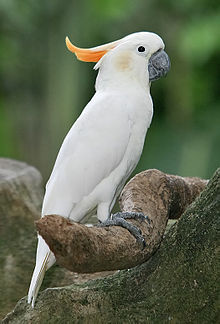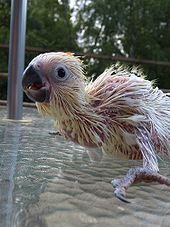- Citron-crested Cockatoo
-
Citron-crested Cockatoo 
Conservation status Scientific classification Kingdom: Animalia Phylum: Chordata Class: Aves Order: Psittaciformes Family: Cacatuidae Subfamily: Cacatuinae Genus: Cacatua Subgenus: Cacatua Species: C. sulphurea Subspecies: C. s. citrinocristata Trinomial name Cacatua sulphurea citrinocristata
Fraser, 1844The Citron-crested Cockatoo, Cacatua sulphurea citrinocristata is a medium-sized cockatoo with an orange crest, dark grey beak, pale orange ear patches, and strong feet and claws. The underside of the larger wing and tail feathers have a pale yellow colour. The eye colour ranges from brown through very dark brown to black. Both sexes are similar.
The smallest of the Yellow-crested Cockatoo subspecies, it is endemic to Sumba in the Lesser Sunda Islands in Indonesia. The diet consists mainly of seeds, buds, fruits, nuts and herbaceous plants.
Contents
Conservation status
The Citron-crested Cockatoo is critically endangered. Its numbers in the wild have declined due to habitat loss and illegal trapping for the cage-bird trade. A 1993 survey of Sumba estimated the species' numbers at less than 2,000 individuals.[1] Together with the other subspecies of the Yellow-crested Cockatoo, it is listed in appendix I of the CITES list.[2] Consequently, international trade is strongly regulated and trade in wild caught Citron-crested Cockatoos is illegal.
Aviculture
 Chick at Děčín Zoo, Czech Republic
Chick at Děčín Zoo, Czech Republic
Being friendly and sociable, hand-reared Citron-crested Cockatoos can make good pets. They are not as noisy as most cockatoos, but are curious and like to chew. They are generally quiet, but they can make a loud honking or screeching sound, which is lower in pitch than the calls of most parrots. They can also make a repetitive quieter whistling or squeaking noise. They are not as good at imitating human speech as some members of the parrot family, although they readily learn behaviors and they can be trained. They often raise the coloured crest feathers in display, when surprised, or to show interest or excitement. Their droppings are semi-solid and can be messy. As with many cockatoo species, Citron-crested Cockatoos taken as pets need much greater care and attention than other companion parrots. In personality, they are often more shy or nervous than other cockatoos and should be allowed to adjust to new circumstances gradually in order to become comfortable.
They are not commonly seen in pet stores, but are becoming more popular with breeders.
References
1. Cahill, A. J., Walker, J. S. & Marsden, S. J. (2006). Recovery within a population of the Critically Endangered citron-crested cockatoo Cacatua sulphurea citrinocristata in Indonesia after 10 years of international trade control.
2. CONVENTION ON INTERNATIONAL TRADE IN ENDANGERED SPECIES OF WILD FAUNA AND FLORA, Thirteenth Meeting of the Conferences of the Parties Bangkok, Thailand, 3 to 14 October 2004. http://www.cites.org/common/cop/13/raw_props/ID-Cacatua.pdf
External links
Cockatoos (family: Cacatuidae) Appearance Small NymphicusBlack Calyptorhynchus
(subgenus)Zanda
(subgenus)ProboscigerPink or grey CallocephalonEolophusLophochroaWhite CacatuaCacatua
(subgenus)Yellow-crested Cockatoo (or Lesser Sulphur-crested Cockatoo) (supporting page: Citron-crested Cockatoo) • Sulphur-crested Cockatoo (supporting page: Eleonora Cockatoo) • Blue-eyed Cockatoo • White Cockatoo (or Umbrella Cockatoo) • Salmon-crested Cockatoo (or Moluccan Cockatoo)Licmetis
(subgenus)Long-billed Corella • Western Corella (supporting pages: Muir's Corella • Butler's Corella) • Little Corella • Tanimbar Corella (or Goffin's Cockatoo) • Solomons Cockatoo • Red-vented CockatooCategories:- IUCN Red List critically endangered species
- Cockatoos
- Birds kept as pets
- Cacatua
- Birds of Southeast Asia
- Birds of Indonesia
- Parrots
Wikimedia Foundation. 2010.

